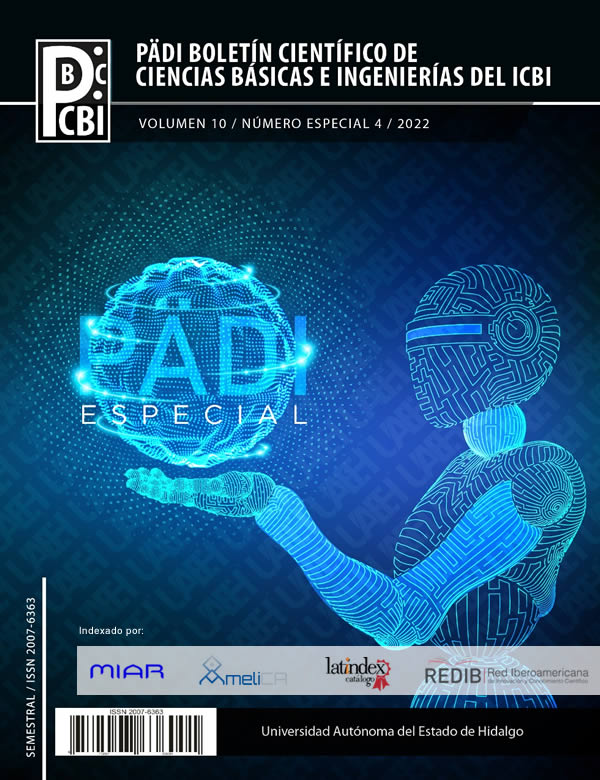Solving drone tasks in simulators
Abstract
In this paper we present solutions to some of the tests included in drone competitions, in particular we consider the tests held in the Mexican Robotics Tournament of the Mexican Federation of Robotics in the virtual drone category. In this context, this work shows the development of some academic applications that have been included in these competitions at national level. Thus, the tests included in this work are: flight over specific points along a path, 3D reconstruction of objects in the environment, flight between windows and formation flying. To solve these tests, computer vision, simultaneous localisation and mapping, traditional control, 3D reconstruction, route planning and machine learning techniques must be used. All of them have been working virtually in different simulators such as Gazebo and AirSim under ROS.
Downloads
References
Ardupilot (2022). Ardupilot - versatile, trusted, open. https://ardupilot.org/. [Fecha de acceso: 2022-03-20].
Chen, L., Tang, W., John, N. W., Wan, T. R., and Zhang, J. J. (2018). Slambased dense surface reconstruction in monocular minimally invasive surgery and its application to augmented reality. Computer Methods and Programs in Biomedicine, 158:135–146.
EpicGames (2022). The world’s most open and advanced real-time 3d creation tool. https://www.unrealengine.com/en-US/. [Fecha de acceso: 2022-03-20].
FIRA (2022). Fira air. https://firaworldcup.org/category/leagues/fira-air/. Fecha de acceso: 2022-03-20.
Gazebo (2022). Gazebo documentation. https://gazebosim.org/docs. Fecha de acceso: 2022-03-20.
IMAV (2022). International micro air vehicles, conferences and competitions. http://www.imavs.org/. Fecha de acceso: 2022-03-20.
Johannes Meyer, S. K. (2022). Hector quadrotor. https://github.com/RAFALAMAO/hector-quadrotor-noetic.
Kazhdan, M. M. and Hoppe, H. (2013). Screened poisson surface reconstruction. ACM Trans. Graph., 32(3):29:1–29:13.
Meyer, J., Sendobry, A., Kohlbrecher, S., Klingauf, U., and Stryk, O. v. (2012). Comprehensive simulation of quadrotor uavs using ros and gazebo. In International conference on simulation, modeling, and programming for autonomous robots, pages 400–411. Springer.
MicrosoftResearch (2022). Welcome to airsim. https://microsoft.github.io/AirSim/. Fecha de acceso: 2022-03-20.
Mur-Artal, R., Montiel, J. M. M., and Tardos, J. D. (2015). Orb-slam: a versatile and accurate monocular slam system. IEEE transactions on robotics, 31(5):1147–1163.
Orozco-Soto, S. M., Ibarra-Zannatha, J. M., Malo-Tamayo, A. J., and Cureño-Ramírez, A. (2018). Active disturbance rejection control for uav hover using ros. In 2018 XX Congreso Mexicano de Robótica (COMRob), pages 1–5.
IEEE.
Parrot (2022). What is parrot sphinx. https://developer.parrot.com/docs/sphinx/. Fecha de acceso: 2022-05-01.
PASCAL2 (2022). The pascal visual object classes homepage. http://host.robots.ox.ac.uk/pascal/VOC/. Fecha de acceso: 2022-03-20.
PX4 (2022). Open source autopilot for drone developers. https://px4.io/. Fecha de acceso: 2022-03-20.
Tagliasacchi, A., Delame, T., Spagnuolo, M., Amenta, N., and Telea, A. (2016). 3d skeletons: A state-of-the-art report. In Computer Graphics Forum, volume 35, pages 573–597. Wiley Online Library.
Tan, M., Pang, R., and Le, Q. V. (2019). Efficientdet: Scalable and efficient object detection. CoRR, abs/1911.09070.
TMR (2022). Drones aut ́onomos. https://www.femexrobotica.org/tmr2021/portfolio-item/drones-autonomos. Fecha de acceso: 2022-03-20.
Zhang, M., Qin, H., Lan, M., Lin, J., Wang, S., Liu, K., Lin, F., and Chen, B. M. (2015). A high fidelity simulator for a quadrotor uav using ros and gazebo. In IECON 2015-41st Annual Conference of the IEEE Industrial Electronics Society, pages 02846–002851. IEEE













